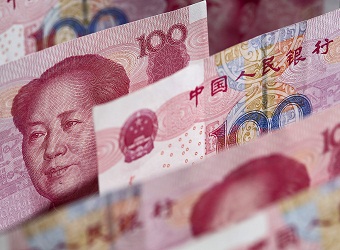Chinese yuan has been on a tear all year and has now recouped last year’s losses — and analysts expect there’s still room to run.
At its strongest level on Tuesday, the yuan was changing hands at 6.5151 against the U.S. dollar, pushing gains to more than 6 percent this year, according to Reuters data. The currency’s appreciation had quickened its pace in August, marking its best month in 2017.
The yuan has strengthened much faster than expected, and it’s even bucked the trend. While other Asian currencies have been falling in the face of rising political tensions between the U.S. and North Korea, the Chinese yuan has actually continued appreciating. Experts say the central bank has succeeded in demonstrating it can withstand downward pressure on the currency by tightening capital controls and with foreign exchange intervention.
There’s even some talk that the yuan is becoming something of a safe-haven play.
The government’s capacity for control “positions the Chinese yuan and China as a source of stability amid uncertain political and economic times,” wrote Callum Henderson, managing director at risk consultancy Eurasia Group, in a note. And “it avoids any possibility that the U.S. administration could accuse China of weakening its currency ahead of the 19th Party Congress and President Donald Trump’s visit to China.”
China’s 19th Party Congress is set to kick off mid-October, and it’s the country’s most important political event in five years, culminating with a change in the upper echelons of leadership. For Beijing, maintaining stability in its economy and markets is a major priority ahead of the power shuffle, which is why the government has been working overtime to support the yuan.
The currency has also been buoyed by a weaker U.S. dollar as buying sentiment for the greenback has soured as the U.S. Federal Reserve has continued signaling it’s unlikely to change interest rates for the rest of this year.
“The combination of improving economic data in China and the ongoing weakness in investment sentiment towards the dollar, is encouraging for the yuan,” said Jameel Ahmad, chief market analyst at FXTM, a forex broker.
At the beginning of the year, many analysts were expecting the yuan to continue its slide against the dollar. But it has instead improved so much this year that it’s already beat many year-end forecasts, prompting analysts to play catch-up with their estimates.
Capital Economics, for instance, issued on Aug. 31 its latest adjusted forecast, with expectations that 6.60 yuan would trade for a U.S. dollar by the end of the year, 6.40 in 2018, and 6.20 in 2019.
But at 9:50 am on Wednesday, the spot rate for the yuan was trading at 6.5311 — already beating the firm’s forecast only a week out of its latest revision. While his firm was early in its calls for the yuan to appreciate, the speed by which it’s occurred has taken many by surprise, said Capital Economics China economist Julian Evans-Pritchard.
Macquarie also sees the yuan appreciating further, forecasting it to hit 6.40 yuan against the dollar over the next 12 months.
Still, a number of risks remain — most notably a longstanding concern that China’s economic growth may falter, and thus, diminish the case for sustained strength in the yuan. There’s also a risk that “strains building in China’s financial system after years of rapid credit growth will precipitate a crisis that in turn will trigger sharp currency depreciation,” wrote analysts at Capital Economics in a recent note.
Another unknown is what reforms, if any, China may choose to pursue after the fall party congress, said Mitul Kotecha, head of foreign exchange strategy for Asia Pacific at Barclays.
Also, it’s important to remember that major moves in any direction for the yuan may not be a good thing from Beijing’s perspective — given its emphasis on keeping calm in the markets this year.
“Stability still seems to be the prime interest here,” said Kotecha. “Dampening volatility, keeping relative stability is probably going to continue to be the aim.”
Source: CNBC


